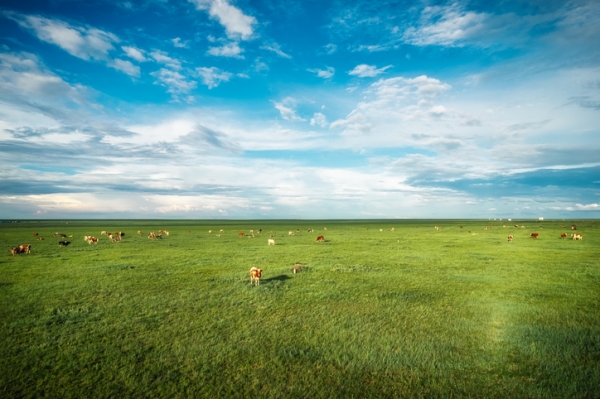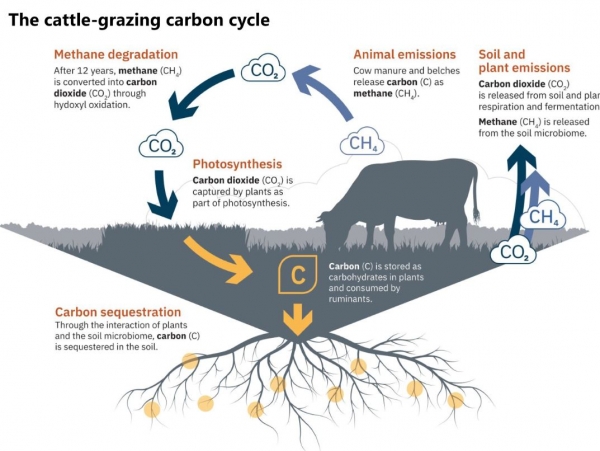[ad_1]
The Archbold–Alltech Alliance, which started in 2019, introduced collectively scientists from two totally different disciplines — ecologists from Archbold and ruminant nutritionists from Alltech — to grasp the influence that cattle manufacturing at Archbold’s Buck Island Ranch, a ten,500-acre ranch in Lake Placid, Florida, has on the ecosystem and the flexibility to sequester carbon.
The findings of their work point out that grazing ruminant animals on land advantages the setting and improves carbon biking.
The companions preserve that their tie-up has found a deeper understanding of the grazing-cattle carbon cycle, one that isn’t solely centered on greenhouse fuel (GHG) emissions from the animal but in addition on pure GHG emissions from the land and the sequestration of carbon within the soil.
Discussions round GHGs and world warming typically focus on agriculture emissions, however you will need to assume past emissions and have a look at the complete cycle, they contend.
Methane in grassland ‘will increase’ when cows are absent
Requested about any surprising or novel insights that emerged from this interdisciplinary method, Vaughn Holder, director of ruminant analysis at Alltech, instructed us:
“Probably the most placing discovering is the invention that beef manufacturing will be carbon adverse. Which means that the land and cattle produce fewer web emissions than is being taken up by the land. One other placing discovering is that in some instances, the methane manufacturing by the land goes up when cattle are usually not current. This reveals us that we can’t merely concentrate on emissions. We have to perceive the entire ecosystem.”
Dr Betsey Boughton, director of agroecology at Archbold, claims its Buck Island Ranch sequesters 1,201 tons of CO2 equal yearly and that all the work accomplished at that web site is scalable to different elements of the world. “The narrative folks have heard is that cows are unhealthy for the setting, however grazing animals can truly change the operate of grasslands. Cows are consuming the grass and never permitting as a lot decomposition to occur on the bottom. With out cows, we truly see extra carbon emitted.”
Carbon movement in pasture areas
The analysis alliance plan to translate the findings from Buck Island Ranch to different areas all over the world.
“Presently, the intent is to make use of the intensive array of knowledge assortment and sensors to construct a mannequin that may enable us to estimate carbon movement in grazing pasture lands. These fashions will then be evaluated in different techniques to guage their robustness,” mentioned Dr Holder.
“We are able to’t simply have a look at emissions. We produce meals from ecosystems, and as such, we have to perceive the movement of vitamins and carbon in these ecosystems to grasp the influence on meals safety and GHGs. We additionally want to grasp that it’s not nearly carbon. Grazed lands are a number of the most biodiverse lands left on this planet, supporting many species that don’t reside anyplace else,” he defined.
Grazed lands, significantly places equivalent to Buck Island Ranch in Florida, can be extraordinarily essential for water high quality and movement administration, Dr Holder added.
Sensors, soil sampling
A number of strategies and methods have been leveraged by the alliance to estimate the carbon footprint of Buck Island Ranch:
“Archbold employs an array of sensors, soil sampling and modeling strategies to have a look at complete ranch carbon actions. A few of these embody eddy-covariance flux towers for measuring ecosystem-level carbon change between the panorama and the environment, direct soil carbon measures, satellite tv for pc imaging, on-farm inputs, ecosystem stage modeling, in vitro evaluation of enteric emissions and complete on-farm mass steadiness calculations. The intent is to make use of a number of sensors and to construct fashions across the output of these sensors.”
Dissemination to wider public
The companions have launched a six-part video sequence on their analysis findings.
“Most of our trade and the general public are likely to solely think about emissions, however we’re lacking out a lot of the story after we don’t think about the influence of grazed lands on different elements of the carbon cycle and ecosystems. We have to perceive the influence of the entire carbon cycle earlier than drawing conclusions on the function of cattle in local weather change.
“These movies tackle the grazing-cattle carbon cycle, the function of carbon sequestration in mitigating local weather change, nutrient upcycling, utilization of meals waste and byproducts — meals safety and GHG impacts, and the variations between methane and carbon dioxide in warming conduct.”
Requested what future analysis initiatives are deliberate by the Archbold-Alltech Alliance to additional discover the potential of agriculture in mitigating local weather change, Dr Holder mentioned: “The tasks described listed below are nonetheless ongoing, and the outcomes of those experiments will decide the long run path of analysis. We’re wanting each at in-feed and pasture-based applied sciences for enhancing plant development and microbial sequestration, and we additionally hope to guage some in-feed methane mitigation quickly.”

Alternate views
A examine involving researchers primarily based in Sweden and within the Netherlands, revealed in November 2023, evaluated the professionals and cons of counting on carbon sequestration in grasslands to offset warming impact of emissions from present ruminant techniques.
The workforce didn’t intention to exactly quantify the extent to which carbon sequestration can offset emissions from ruminant techniques. As an alternative, the authors outlined how their objective was for instance an method that enhances understanding of the general local weather influence of ruminant techniques, whether or not they contribute to GHG emissions or operate as sinks.
They famous that carbon sequestration in grasslands has been proposed as a big technique to counterbalance GHG emissions from ruminant techniques: To totally grasp the potential and constraints of this method, they imagine it’s important to acknowledge that soil carbon sequestration offers a profit inside a restricted interval, and there are inherent disparities between short- and long-lived GHGs.
Their evaluation demonstrated that one ton of sequestered carbon can neutralize the radiative influence of a steady emission equal to 0.99 kg of methane or 0.1 kg of nitrous oxide yearly over a century. To offset the continuing methane and nitrous oxide emissions from the worldwide ruminant sector, roughly 135 gigatons of carbon can be required—almost twice the present world carbon inventory in managed grasslands, they preserve. This suggests that for numerous areas, grassland carbon shares would wish to extend, starting from 25% to 2,000%.
Consequently, relying solely on carbon sequestration in grasslands to counterbalance the warming results of emissions from present ruminant techniques is deemed impractical, mentioned the scientists.
Nonetheless, they acknowledged the significance of preserving and enhancing present soil natural carbon shares in grasslands to mitigate local weather change and enhance total soil well being, resulting in potential advantages equivalent to enhanced water retention, biodiversity, and grassland productiveness.
[ad_2]


